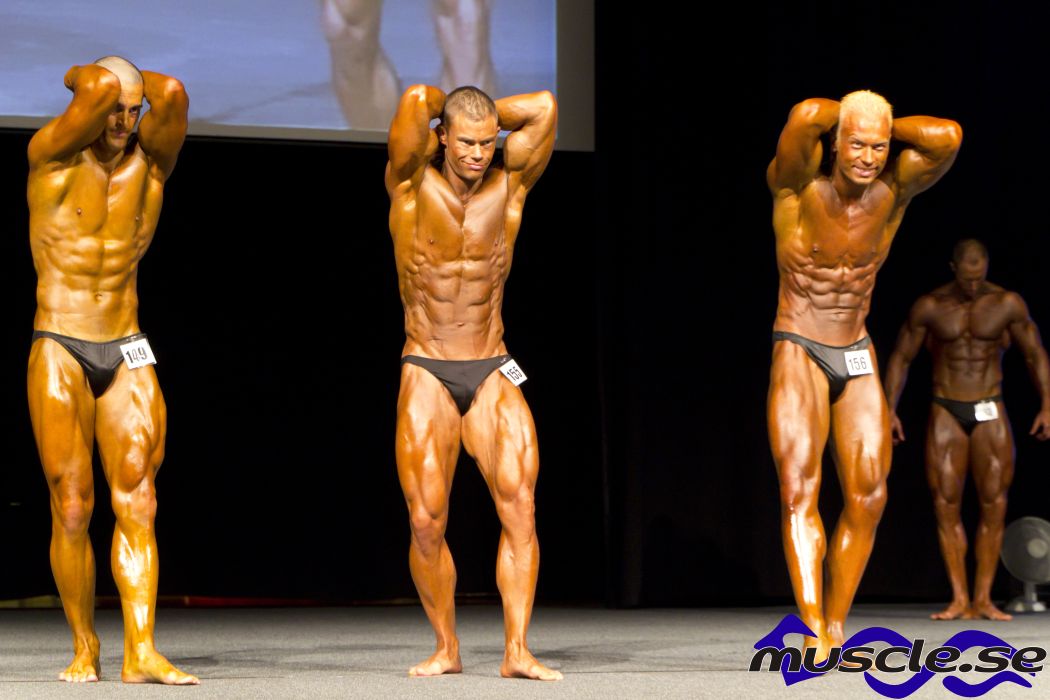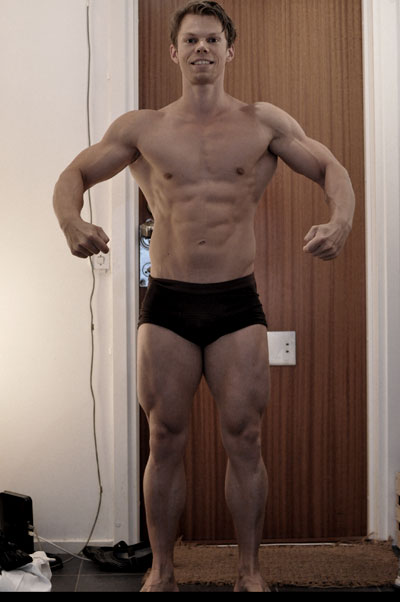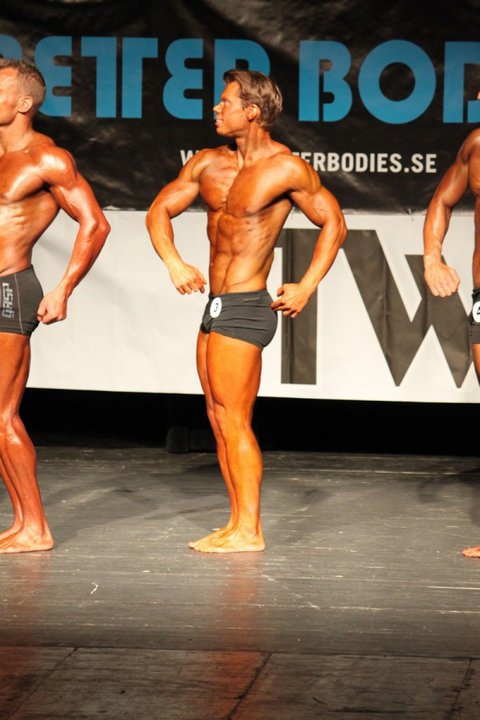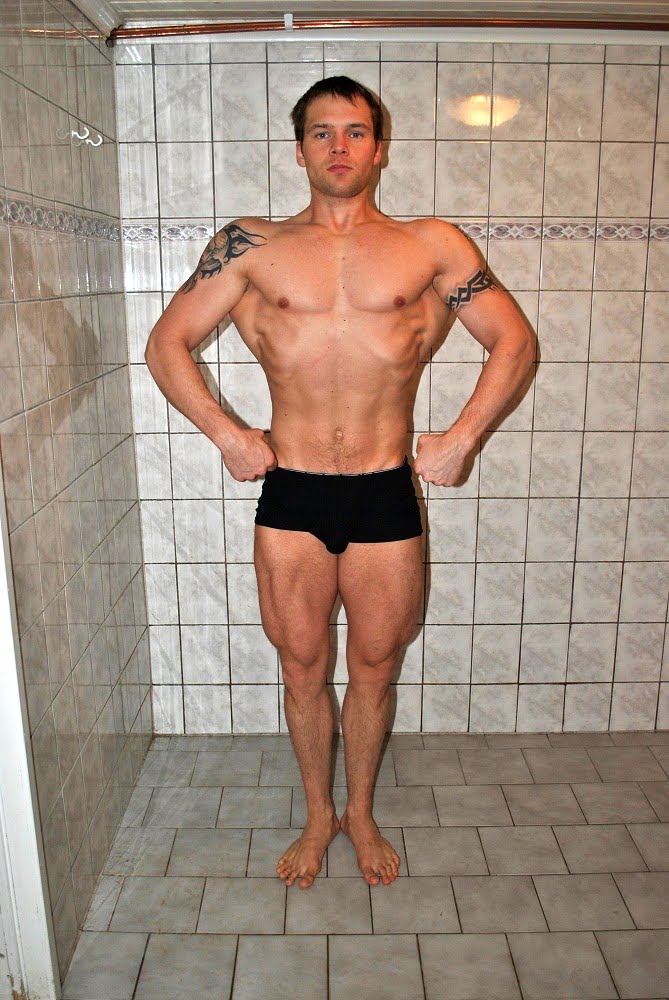What is the maximum muscular potential of drug-free athletes or natural bodybuilders? And what does it take to get there? That’s the topic I’m going to revisit today.
I’ve talked about the maximum muscular potential before in the short article “What’s my Genetic Muscular Potential”, where I presented a formula based on the heights and body weights of natural bodybuilders on competition day (i.e. 5-6% body fat).
Suffice to say, the bodybuilders that appear on the cover of muscle magazines serves as poor role models for what’s possible without “assistance”. Establishing reasonable goals and limits for natural bodybuilders and athletes is important in order to put things into context. A ripped 170-180 lbs is often scoffed at in some circles. You’re not “big” until you’re 210-220 lbs (or so the talk goes). What these people don’t realize is that ripped 170-180 lbs would look very impressive on a guy of average height. In fact, few natural guys will ever achieve those stats due to the consistency in training that it requires.
- 29th Dec Update: “Applying the Formula: Theory vs Real Life” (Fourth section from the bottom.)
- 31st Dec Update: “Limits of The Formula” (Third section from the bottom.)
- “The Law of Diminishing Returns.” (Second section from the bottom.)
A No Bullshit Formula
The formula is simple, yet surprisingly accurate and predictive of real world results.
The formula goes as follows:
(Height in centimeters – 100) = Body weight in kilo (“shredded”, i.e. 5-6% body fat).
Example: If your height is 180 cm (5’11), subtract 100 and you get 80.
80 kg (176 lbs) is your maximum muscular potential when you are in peak condition; rock hard abs with visible veins running across them, striated arms and delts, and so forth. Scroll down a bit to see examples of what I mean.
Now, the inquiring mind would probably like to know why I determine the formula by “ripped” body weight and not something a little more moderate like 10-12% body fat. 10-12% body fat is still lean and a great look if you’ve got some muscle behind that.
Well, the reason is that competition day body weight is the best standard to use. If you want to predict maximum muscular potential with any reasonable precision, you need to have some kind of equalizer. Saying you can get to this and that body weight without drugs doesn’t mean anything unless you consider the body weight in relation to height and body fat percentage. On competition day, most guys are typically in a fairly tight interval of body fat percentage (4-6%) which makes this a good standard.
Furthermore, competitors usually have years of consistent training behind them, which makes another case for drawing conclusions based on competition weight.
Fine Tuning The Formula
Another question that might pop up is how much your “hydrated” body weight would be, as the body weight on the weigh in before competition day will be lower than usual. This will vary a bit depending on the type and severity of water manipulation and depletion protocol.
I typically see a 2% drop in body weight that is independent from regular weight loss. Meaning that the body weight of my clients drops 2% in the final days and then rebounds back up by the same amount once normal feeding resumes.* Then again, I use a very easy and non-dramatic approach compared to others, i.e. no glycogen depletion (!) and no hardcore sodium/water manipulation.
*Actually that’s not quite true as there is a larger rebound first, after which body weight settles down again. This has to do with sodium manipulation and is temporary.
So basically, the formula is closer to (height in cm) – 98 = kg body weight when hydrated.
Furthermore, while 100 is a nice and round number, you’ll obviously see some variance here as well. All things considered, a more precise formula for maximum muscular potential would look a little something like this:
- (Height in cm) – 98-102 = kg body weight on competition day. Ripped and slightly dehydrated.
- (Height in cm) – 96-100 = kg body weight. Ripped and under normal circumstances.
Is this formula the final word on maximum muscular potential? Well, I’ve only known a handful of guys who I was 100% sure of being natural. They all abide by this rule. As with everything, there are outliers but I’ve yet to meet anyone who I was sure of being natural that exceeded the body weight yielded by the formula by a significant amount (i.e. height – 90-95).
This is a very controversial topic. Can I possibly know for sure that the clients I’m about to post as examples of maximum muscular potential are really clean? Can you know I’m clean? Well, of course not. I’m as skeptical and cynical as the next guy (more so), so all of this really boils down to me trusting my clients and you trusting me. Now that I’ve covered that, rest assured that I am not interested in any philosophical argument or debate that starts with “You can’t really know…”, etc.
Without further ado, below you’ll see examples of natural clients that competed fairly recently. A breakdown of their height and body weight on competition day will follow afterwards. While I won’t go as far as saying that they’ve all reached their ceiling in terms of muscle gains, they’ve come very far. I will also tell you what each one of them has in common: what it takes to reach your maximum muscular potential without the use of drugs.
It’s worth noting that Andreaz and Robert were both tested and passed (2 out of a total of 6 doping tests done that day).
Marcus
Marcus made it to the finals and placed 6th out of 17 competitors in Luciapokalen Classic Bodybuilding +178 cm two weeks ago. Considering this was his first competition, that’s an exceptional result. Even more so impressive when you take into account that he didn’t even practice his routine for the finals and just went on stage and struck a few poses at random 😀 I would have done the same…I don’t have much love or interest in usual proceedings on competition day.
Anyway, below you’ll see pictures from Marcus’s bulk, at 185 lbs/84 kg and lean, to competition day at 175 lbs/79 kg and shredded (height: 181 cm).
The whole process took 8 weeks which is a very short diet compared to the norm (same for Andreaz and Robert). I helped Marcus out during his bulk and as you can see he kept his body fat percentage in check.
“Off-season” (8 weeks out)

3 Weeks Out


Competition Day


Andreaz
Nordic bodybuilding champ Andreaz decided to try his hand at the Athletic Fitness Championship in September. He placed 5th out of 8 in the -180 cm class.
7 Weeks Out

2 Weeks Out

Competition Day


Robert
Robert competed in the same competition as Andreaz. He placed 5th out of 8 in the tall class (+180 cm).
8 Weeks Out

4 Weeks Out
Competition Day

Height and Body Weight Breakdown
- Marcus: 181 cm/79 kg (-102). Estimated body fat on competition day: 4-4.5%.
- Andreaz: 169 cm/69-71 kg (-100/-98). Estimated body fat on competition day: 5-6%. Weight varies slightly; Andreaz was drier in his last bodybuilding competition and weighed in at 69 kg (-100). However, being too ripped on stage for Athletic Fitness can get you minus points. Not taking it too far this last time was a planned and conscious decision.
- Robert: 182 cm/82 kg (-100). Estimated body fat on competition day: 7%.
- Myself: 186 cm/87.5 kg. With an expected water loss of 2%* body weight as mentioned earlier, my stats would put me at 186 cm/86 kg (-100) on competition day (5.5% body fat). I’m including myself for reference and an additional data point. I haven’t competed but I am natural.
(For more on my progress, check out “My Transformation” and the tag with the same name.)
As you can see, there is no substantial variance in the body weights of these natural trainers. Everyone ends up weighing their height – 100, or very close to it, on competition day.
Applying The Formula: Theory vs Real Life
It didn’t take long before this article was published before there was an influx of genetic marvels in discussion forums that claimed my formula was wrong and that they would surpass it once they got down to the body fat percentage it applies to.
Well, I got news for the keyboard experts out there; you’re wrong. Here’s why:
- You’re most likely fatter than you think. There’s a lot of 5’11 200-225 lbs guys with 10-12% body fat on the Internet. In reality, their “10-12%” body fat is more like 15% body fat or more. Everyone thinks they’re on their way to single digit body fat as soon as they see a blurry four-pack in the right lighting.
- You can’t use your current body weight in the calculation if you’re bulking. It’s not uncommon to see an instant 2-5 lbs drop in body weight after one week of dieting depending on carb intake and size, and that ain’t 2-5 lbs of fat you’re losing. It’s some of your overstocked glycogen stores dropping, causing water loss. Reduced stomach content is also a contributing factor.
If you want to make any reasonable estimate based on theoretical calculation of your stats, take your average body weight in the second week of dieting and use that in the formula.
Key point: Your final body weight at 5-6% will be a lot less than what you think. So to all you keyboard experts that arrive at some fantasy stats and claim that my formula is wrong: bitch, please. Talk to me again when you get in contest shape.
Limits of The Formula
- The formula is for men only. I have not worked with a sufficient sample of female physique athletes to establish an accurate formula for female maximum muscular potential.
- The formula assumes average genetics. A minority of the population falls into the category of “non-responders” to resistance training and might not ever reach the same maximum muscularity as the rest of the population no matter what they do. Along the same lines, there are high-responders that might possibly exceed the formula. However, in my experience, high-responders simply gain muscle mass faster than someone of average genetics; the cap for maximum muscular potential (height – 100) does not seem to be raised by much.
- The formula is not perfectly linear and is most accurate for men in the 170-190 cm height range. Very accurate for guys smack dab in the middle of that range (180 cm). Shorter guys (below 170 cm) seem to skew the formula towards being heavier. Vice versa for taller guys. In reality, the standard height – 100 formula might look a little something like this depending on height.
- 190 cm: height – 101
- 180 cm: height – 100
- 170 cm: height – 99
- 160 cm: height – 98
The Law of Diminishing Returns
Am I saying that height (in cm) – 100 is the absolute limit for most drug-free athletes? No, but I’m saying it’s pretty damn close and that the true limit will not differ from height – 100 in any meaningful way. This can be explained by the law of diminishing returns.
During the first six months of weight training, one might see a muscle gain of 1.5-2 lbs per month; that sweet newbie magic, where you gain muscle at a rapid rate. It’s not uncommon to see that muscle gain accompanied by fat loss.
After six months and through the second year, you might see muscle gain of 1 lbs per month. You’re able to increase weights linearly in the gym and everything is still pretty awesome.
Things slows down significantly in the third year, to the tune of about 0.5 lbs muscle gain per month.
In the 4-5th year of training, progress is slow. 1 lb of muscle every 4th month.
5-10th year, 1 lb per year.
Beyond a decade of consistent weight training…well, you get the point. You might be lucky to see 0.5-1 lb of muscle every other year or so. These figures are not exact by any means and progress will obviously vary depending on genetics, training, diet, etc. My point is that the law of diminishing returns kicks in real hard once you hit height – 100. Muscle gains slows down to a snail’s pace. A trainer that hits height – 100 after 12 years of consistent training will not be that much bigger on his 17th year of consistent training.
What It Takes to Reach Your Maximum Muscular Potential
What do we, the guys above and myself that is, have in common besides having achieved a very similar level of muscularity? What factors are important if you hope to reach your maximum muscular potential?
- Consistency. We’ve all been weight training for more than a decade. I for one lost many years due to foolish diets and training regimens – but for better or worse, that’s part of the process. I never gave up in trying to find what’s right for me and that’s what matters in the end. I stayed consistent no matter what.
With the right approach from the get go, you could probably save a ton of time. That being said, you can’t reach your genetic ceiling in six months like some internet marketers wants you to believe. It takes consistency and patience to reach your maximum muscular potential.
- Hard work – but not HARD work. Your workouts should be hard in the sense that you push yourself, but not hard in the sense that going to the gym feels like a burden. Don’t buy into the myth that you need to live the life of a stereotypical bodybuilder to build an impressive physique. Going to the gym shouldn’t interfere too much with the rest of your life. Remember, you’re in for the long haul.
I’ve spent less than 2 hours per week on average building my physique, but I’ve done so over a long period of time. This partly comes back to the point I made above about consistency. Naturals who spend 5-6 days at the gym per week usually don’t last long. They burn out and end up looking mediocre 10 years down the road.
- Measure and quantify your progress. Only then can you tell if something really is working. Measure progress short term and long term and do it in hard numbers; your body weight and what kind of weight you could handle at that body weight are two very important variables to track. Log all your workouts and use a checkpoint system. For more on this, read “How to Look Awesome Every Day.”
Not only is measuring and quantifying vital to make progress but it’s also a great aid in order to find and maintain your motivation in the long-term. Going to the gym becomes a joy once you see your progress manifest itself in hard numbers. And if the hard numbers improve, so will your body.
OK, so this post actually started out as a client update, but then I went off on a tangent and started writing about something different. Anyway, that’ll be all for tonight.
P.S. As you may realize now, the various rumors that has been floating around about my demise after the latest cheesecake showdown are untrue. I survived, but just barely. Right now I’m sick of thinking or writing about anything related to cheesecakes. However, when the time is right, I shall show you exactly what went down that fateful Christmas Eve.
Speaking of cheesecake mastery, I am pleased to see that my teachings have inspired many aspiring cheesecake masters: “Cheesecake Mastery 2010 Death Match.”











